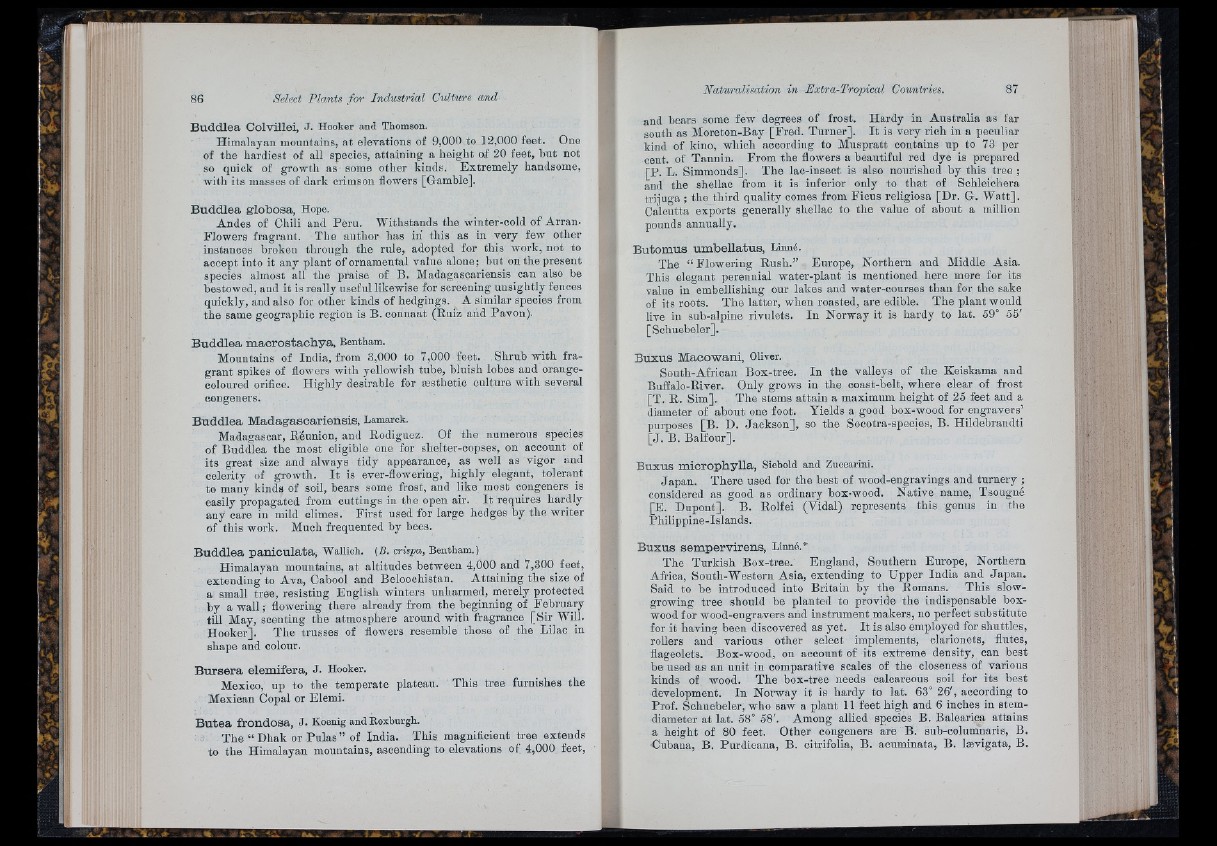
Select Plants for In d u stria l Culture and
1
I r
B u d d le a C o lv ille i, J. Hooker and Thomson.
Himalayan mountains, at elevations of 9,000 to 12,000 feet. One
of the hardiest of all species, attaining a height af 20 feet, but not
so quick of growth as some other kinds. Extremely handsome,
with its masses of dark crimson flowers [Gamble].
B u d d l e a g lo b o s a , Hope.
Andes of Chili and Peru. Withstands the winter-cold of A rran.
Flowers fragrant. The author has in this as in very few other
instances broken through the rule, adopted for this work, not to
accept into it any plant of ornamental value alone; but on the present
species almost all the praise of B. Madagasoariensis can also be
bestowed, aud it is really useful likewise for screening unsightly fences
quickly, and also for other kinds of hedgings. A similar species from
the same geographic region is B. eonnaat (Ruiz and Pavon).
B u d d le a m a o r o s ta o h y a , Bentham.
Mountains of India, from 3,000 to 7,000 feet. Shrub with fragrant
spikes of flowers with yellowish tube, bluish lobes and orange-
coloured orifice. Highly desirable for æsthetic culture with several
congeners.
B u d d le a M a d a g a s o a r ie n s is , Lamarck.
Madagascar, Réunion, and Rodiguez. Of the numerous species
of Buddlea the most eligible one for shelter-copses, on account of
its great size and always tidy appearance, as well as vigor and
celerity of growth. I t is ever-flowering, highly elegant, tolerant
to many kinds of soil, bears some frost, and like most congeners is
easily propagated from cuttings in the open air. I t requires hardly
any care in mild climes. P irst used for large hedges by the writer
of this work. Much frequented by bees.
B u d d le a p a n i c u l a t a , Wallich. (B. crispa, Bentham.)
Himalayan mountains, at altitudes between 4,000 and 7,300 feet,
extending to Ava, Cabool and Beloochistau. Attaining the size of
a small tree, resisting English winters unharmed, merely protected
by a wall; flowering there already from the beginning of February
till May, scenting the atmosphere around with fragrance [Sir Will.
Hooker]. The trusses of flowers resemble those of the Lilac in
shape and colour.
B u r s e r a e lem if e r a , J. Hooker.
Mexico, up to the temperate plateau.
Mexican Copal or Elemi.
B u t e a f r o n d o s a , J. Koenig and Roxburgh.
This tree furnishes the
The “ Dhak or Pulas ” of India. This magniflcient tree extends
to the Himalayan mountains, ascending to elevations of 4,000 feet.
and hears some few degrees of frost. Hardy in Australia as far
south as Moreton-Bay [Fred. Turner]. I t is very rich in a peculiar
kind of kino, which according to Muspratt contains up to 73 per
cent, of Tannin. From the flowers a beautiful red dye is prepared
[P. L. Simmonds]. The lac-insect is also nourished by this tre e ;
and the shellac from it is inferior only to th a t of Schleiehera
trijuga ; the third quality comes from Ficus religiosa [Dr. G. Wa tt].
Calcutta exports generally shellac to the value of about a million
pounds annually.
B u tom u s u m b e l l a tu s , Linné.
The “ Flowering Rush.” Europe, Northern and Middle Asia.
This elegant perennial water-plant is mentioned here more for its
value in embellishing our lakes and water-courses than for the sake
of its roots. The latter, when roasted, are edible. The plant would
live in sub-alpine rivulets. In Norway it is hardy to lat. 59° 55'
[Schuebeler].
B u x u s M a c ow a n i, Oliver.
South-African Box-tree. In the valleys of the Keiskama and
Bufialo-River. Only grows in the coast-belt, where clear of frost
[T. R. Sim]. The stems attain a maximum height of 25 feet and a
diameter of about one foot. Yields a good box-wood for engravers’
mrposes
J . B. Ba
"B. D. Jackson], so the Socotra-species, B. Hildebrandti
Your].
B u x u s m ic r o p h y l la , Siebold and Zuccarini.
Japan. 'There used for the best of wood-engravings and turnery ;
considered as good as ordinary box-wood. Native name, Tsougné
[E. Dupont]. B. Rolfei (Vidal) represents this genus in the
Philippine-Islands.
B u x u s s e r u p e r v ir e n s , Linné.*
The 'Turkish Box-tree. England, Southern Europe, Northern
Africa, South-Western Asia, extending to Upper India and Japan.
Said to be introduced into Britain by the Romans. This slow-
growing tree should be planted to provide the indispensable boxwood
for wood-engravers and instrument makers, no perfect substitute
for it having been discovered as yet. I t is also employed for shuttles,
roUers and various other select implements, clarionets, flutes,
flageolets. Box-wood, on account of its extreme density, can best
be used as an unit in comparative scales of the closeness of various
kinds of wood. The box-tree needs calcareous soil for its best
development. In Norway it is hardy to lat. 63° 26', according to
Prof. Schuebeler, who saw a plant 11 feet high and 6 inches in stem-
diameter at lat. 58° 58'. Among allied species B. Balearica attains
a height of 80 feet. Other congeners are B. sub-oolumnaris, B.
■Cubana, B. Purdieana, B. citrifolia, B. acuminata, B. lævigata, B.
Í. Ì. :..
I fri*
fri;
I p N
i'frV